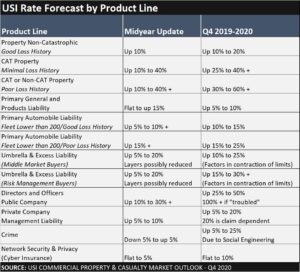Ongoing rate increases and reductions in capacity are taking shape in most property/casualty commercial lines in the fourth quarter–and for some, will continue into the new year, according to a recent report from broker USI Insurance Services.
Only one line–loss sensitive workers’ compensation accounts–showed lower rate forecasts for the fourth quarter vs. midyear, while seven others stayed the same.
The other 20 lines, including all property lines, general liability, umbrella and cyber, had indications of higher rate changes for the fourth quarter than at midyear, according to USI’s Q4 2019-2020 P&C Insurance Market Outlook Report that looks at 28 different product lines along with forecasts from a prior midyear update compared to observations of fourth-quarter pricing.
Other Report Highlights
In property insurance lines, wildfire is no longer a throw in.
Three market leaders, AIG, FM Global and Lloyd’s of London, are highly scrutinizing their North American property business impacting capacity, rates, and coverage.
In casualty insurance, the firming of the insurance market for the majority of coverage lines is not being driven by capacity constraints but rather because capital is being deployed much more conservatively and selectively.
Unlike commercial automobile liability, for which the market has been firming over a three or four-year time frame, for primary general/products liability and umbrella/excess liability, the market firmed rapidly beginning in fourth-quarter 2018.
Prior attempts to raise rates in prior years were short-lived but the current environment of more restrictive risk selection, tighter underwriting standards and reduced competition is turning out to be much more uniform, prolonged and severe than anticipated.
Markets are increasingly unwilling to write primary liability lines on a standalone basis without workers compensation, especially for larger accounts.
Deteriorating casualty loss trends characterized by increased frequency of severity losses has caused markets to exit certain lines, reduce capacity and raise rates considerably. These activities cut across all industries and classifications regardless of tenure with markets or past loss history.
The demand for casualty rate increases is not expected to slow dramatically for the duration of 2019 and into the third- or fourth-quarter of 2020.
USI has seen a reduction in average lead umbrella capacity of $25 million fall down to $15 million or less, with no corresponding decrease in rates and the reallocation of capacity higher up in towers.
Excess markets are walking away from what they view as below-market pricing; new market capacity is not entering.
In public directors and officers liability (D&O), USI said it has seen more upward rate movement in the first three-quarters of 2019 than it has witnessed in the past 16 years.
“We have clearly now transitioned into a carrier-dictated market,” the report states.
In cyber, the flat-to-10 percent rate change indications shown on the chart above, aren’t the rule for large companies or prime targets.
For those over $1 billion in revenue and for insureds in “challenging classes” like retail, hospitality, health care and financial institutions, USI has seen increases in premium of up to 20 percent and SIR increases of up to 50 percent– and the broker expects this to continue for the balance of this year and through the first half of 2020.
Was this article valuable?
Here are more articles you may enjoy.


 Study Urges Rethinking of Disaster Management in Era of Compounding Events
Study Urges Rethinking of Disaster Management in Era of Compounding Events  Deere Retreats From Diversity Measures After Online Attacks
Deere Retreats From Diversity Measures After Online Attacks  Man Admits to Tracking Drivers, Programming Keys, Stealing and Reselling Vehicles
Man Admits to Tracking Drivers, Programming Keys, Stealing and Reselling Vehicles  Travelers Reverses Q2 Income Loss, Narrows Underwriting Loss
Travelers Reverses Q2 Income Loss, Narrows Underwriting Loss 


